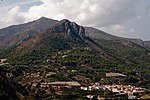Callosa d'en Sarrià

Callosa d'en Sarrià (Valencian: [kaˈʎoza ðen sariˈa] is a Valencian town and municipality located in the comarca of Marina Baixa, in the province of Alicante, Spain, lying in the valley of the river Guadalest, 50 km from the city of Alicante. Callosa d'en Sarrià has an area of 24.8 km2 and according to the 2003 census, a total population of 8,060 inhabitants. The economy of Callosa is chiefly based on tourism and agriculture: it is the main producer of loquat in Spain. The most important monuments in the town are the Catholic archipresbyteral church of Sant Joan Baptista (Saint John), built in the 18th century, and the Fortress of Bèrnia, built in the 17th century at the top of a nearby mountain to defend the city from pirates and Moriscos.
Excerpt from the Wikipedia article Callosa d'en Sarrià (License: CC BY-SA 3.0, Authors, Images).Callosa d'en Sarrià
Plaza de Espanya,
Geographical coordinates (GPS) Address Nearby Places Show on map
Geographical coordinates (GPS)
| Latitude | Longitude |
|---|---|
| N 38.651388888889 ° | E -0.12277777777778 ° |
Address
Canina
Plaza de Espanya
03510
Valencian Community, Spain
Open on Google Maps








